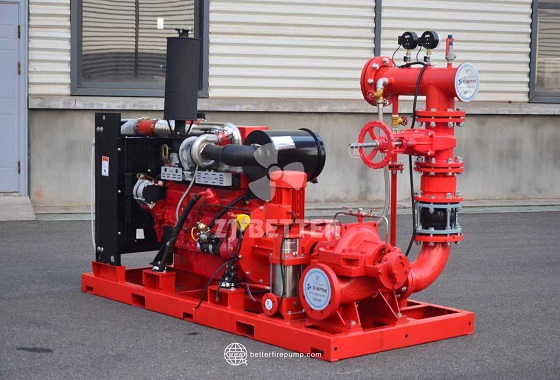The stability of the water supply system is crucial in fire safety systems. Traditional electric fire pumps may not function properly during power outages or unstable power conditions, hampering firefighting efficiency. Emergency backup power fire pumps are designed to address this challenge. Powered by a diesel engine, they can continuously provide powerful hydraulic support in powerless environments, providing reliable fire safety for a wide range of locations, including buildings, factories, petrochemical plants, and warehouses.
1. Design Purpose of Emergency Backup Power
The core advantage of emergency backup power fire pumps lies in their grid-independent operation. Traditional electric pumps rely on an external power source, which can be easily damaged or automatically shut down during a fire, leading to water supply interruptions. This unit, powered by a diesel engine, can be immediately operational even in a complete power outage. This design ensures continuous firefighting water supply at the most critical moments, significantly improving the reliability of the firefighting system.
2. Efficient Power Output System
The diesel engine in this pump can quickly reach rated speed, providing powerful power to drive the pump. Compared to electric motors, diesel engines offer more stable output power, making them particularly suitable for long-term, high-flow water supply needs. Its fuel system has been optimized to ensure a balanced balance between combustion efficiency and energy consumption, enabling rapid and sustained power support in emergency situations.
3. Stable Hydraulic Performance
The hydraulic design of this emergency standby power fire pump emphasizes a balance between high head and large flow rate, ensuring it can meet diverse water needs, from high-rise building sprinklers to large factory fire hydrants. The pump body is constructed of wear-resistant materials, and the internal hydraulic flow path has been optimized through fluid dynamics to reduce energy loss and achieve efficient and stable water supply. This not only meets the stringent requirements of fire protection systems but also extends the service life of the equipment.
4. Intelligent Control and Automatic Switching
Modern emergency standby power fire pumps are generally equipped with an intelligent control system that automatically detects power status. If a mains power outage occurs, the system automatically switches to diesel engine operation within seconds. Furthermore, the control cabinet features real-time monitoring of fuel level, water pressure, pump speed, and operating status, ensuring stable and reliable operation during fully automatic operation. Operators can also intervene manually, enhancing system flexibility.
5. Fuel Economy and Runtime
Fuel economy and continuous run time are crucial for firefighting equipment. This type of fire pump typically features a large-capacity fuel tank and an efficient fuel injection system to ensure extended run time. For example, a single tank of fuel can provide several hours of uninterrupted operation, more than enough to handle most firefighting operations. Furthermore, its excellent fuel economy reduces overall operating and maintenance costs.
6. Compact Structure and Easy Installation
Emergency standby power fire pumps utilize a skid-mounted or integral frame structure, resulting in a compact design and a small footprint, making them easy to install in limited spaces. The equipment is typically fully commissioned before shipment, allowing users to complete simple piping and electrical connections on-site before commissioning. This integrated design not only shortens the construction period but also significantly reduces installation complexity, making it particularly suitable for emergency response projects requiring rapid deployment.
7. Adaptability to Complex Environments
Fires often occur in extreme or unpredictable environments, and the design of emergency standby power fire pumps takes adaptability into full consideration. Its engine and pump body offer excellent resistance to high temperatures, humidity, and corrosion, ensuring stable operation even in hot, smoky, or humid environments. Furthermore, its high level of protection allows for long-term outdoor use in rain and dust, ensuring a wide range of applications.
8. Multi-Industry Application Value
This fire pump is not only suitable for high-rise buildings and residential communities, but is also widely used in industries with stringent fire safety requirements, such as the petrochemical industry, power plants, warehousing and logistics, and airports and ports. In specialized locations with unstable power sources, such as mining areas, remote construction sites, and large convention and exhibition centers, emergency backup power fire pumps are indispensable firefighting equipment. Its multi-scenario applicability provides users with a more comprehensive firefighting solution.
9. Reliable Safety Protections
The equipment not only emphasizes performance output but also features multiple safety protection features, such as low oil pressure alarms, over-temperature alarms, low fuel warnings, and automatic shutdown protection. These features effectively prevent operational interruptions caused by equipment failure and reduce safety risks associated with improper operation. The multi-faceted protection design provides users with a higher level of user security.
10. Easy Maintenance and Long Life
The emergency standby power fire pump is designed for easy maintenance. Key components feature a modular design for easy replacement and overhaul. The robust design of the lubrication and cooling systems also reduces the need for routine maintenance. Routine fuel replenishment, oil changes, and regular inspections ensure long-term stable operation. Its durability and low maintenance costs significantly extend its overall service life.
As a vital component of modern firefighting systems, the emergency standby power fire pump is renowned for its independent power supply, stable performance, and high reliability. It not only solves water supply issues during power outages, but also addresses fuel efficiency, intelligent control, and multi-industry applications. For users seeking high safety and security, this device is undoubtedly the most valuable choice in firefighting systems, providing continuous and powerful support for fire prevention and control.
